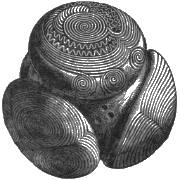Canmore Site 37488: ISLAY, ARDNAVE - KILCHOMAN - ENCLOSURE (PERIOD UNASSIGNED), HUT CIRCLE (PREHISTORIC)
Description
| Site Name | ISLAY, ARDNAVE |
|---|---|
| Other Name(s) | ARDNAVE 2, ISLAY |
| Site Number | NR27SE 22 |
| Broad Class | MONUMENT (BY FORM), DOMESTIC |
| Site Type(s) | ENCLOSURE (PERIOD UNASSIGNED), HUT CIRCLE (PREHISTORIC) |
| NGR | NR 2899 7458 |
| NGR accuracy | NGR given to the nearest 10m |
| Local Authority | ARGYLL AND BUTE |
| Parish | KILCHOMAN |
| Record created | 1988-03-21 |
| Last updated | 2006-08-11 |
Archaeology Notes
NR27SE 22 2899 7458.
(NR 2899 7458) Settlement site. A "rosette" pin and a "P-shaped" brooch each dating to about the 3rd century AD were found during examination of a small stone hearth and an associated shell heap which had been exposed in the sand dunes by erosion. Excavated by RCAHMS in 1977.
RCAHMS 1977.
The hearth has been reconstructed, and is on display in Islay Museum. The brooch has been presented to the National Museum of Antiquities of Scotland (NMAS), and a replica will be lodged in Islay Museum. Mr Black pointed out the precise find spot of the hearth in an extensive bunker in which a number of shell middens are exposed, but no structures can be recognised.
Visited by OS (N K B) 19 June 1978.
Excavations in the sand-dunes 1.8km NE of Ardnave carried out between 1977 and 1980 revealed a house of Bronze Age date overlain by midden deposits, two hearths of Iron Age date, and a stone-walled enclosure, the date of which is not known. This account is a summary of the published report. (RCAHMS 1977)
This house had not been a free-standing structure but has been set in a hollow in the sand-dunes; the W side had been
destroyed by erosion but the wall-face on thp nihpr three sides remained intact, the enclosed area measuring 9m by at
least 7m. The wall stood to a height of 0.9m, built upon a foundation of massive boulders. The entrance had
presumably been on the w side. A hearth, situated a little to the N of the centre of the interior and underlying a secondary wall, provided a radiocarbon date of 1730 bc ? 65 (GU-1439).
Although there were many internal post-holes, no coherent pattern could be made out. The N third of the house was
remodelled to form a smaller dwelling measuring some 4.5m by 3m; this made use of the N wall of the original house, but an internal wall was added with a pair of large portal-stones on each side of the entrance. Immediately in front of the entrance there was a pit, which contained a complete Food Vessel. Radiocarbon dates for material from the occupation levels within the smaller house range from 1737 be ? 60 (GU-1114)tol375bc?80(GU-1274).
Subsequently the structures were engulfed by blown sand, but layers of midden material, overlying the sand and
containing pottery, flint and bones, provided a radiocarbon date of 1280 bc? 120 (ou-1272), suggesting that occupation
continued in the immediate vicinity of the house.
In 1977, at a point some 22m NW of the house, a hearth was uncovered; D-shaped on plan, it measured 0.85m by 0.68m within slabs that protruded up to 0.18m above the paved floor. It was associated with a bronze rosette-headed pin and a bronze brooch, belonging to distinctive types of 3rd- or 4th-century AD date. A second hearth, excavated in 1980 some 10m sw of the house, was found to have been disturbed, but two uprights and an area of paving survived, showing that it had originally measured about 1.2m by 0.7m; charcoal from it provided a radiocarbon date of ad 195 ? 60 (GU-1443) for this occupation horizon.
To the W of the house the wall of a rectilinear enclosure can still be detected, the E part of which, however, has been destroyed; measuring 30m from N to S, the stones of the wall provide a slight revetment holding back the sand from the enclosed area. No signs of a cultivated land-surface were found inside and the date and purpose of the enclosure are not known.
The first hearth and some pottery vessels are preserved in the Museum of Islay Life, Port Charlotte; the remaining
small finds are in the National Museum of Antiquities of Scotland.
Visited October 1980
RCAHMS 1984
Identifiers and Links to Other Records
Would you like to help find more links?
This area is visible only to logged in users.
